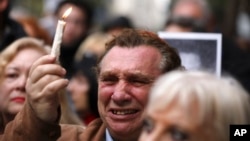On July 18, 1994, an explosion destroyed the Buenos Aires headquarters of the Argentine-Israelite Mutual Association, a Jewish community center. The worst such attack in the history of Argentina killed 85 people and injured more than 300.
Official reports established that the attack on the center, known by its Spanish initials AMIA, was carried out with a car bomb. Prosecutors blamed former Iranian officials who would have operated through Hezbollah and a local contact.
Authorities have maintained these conclusions, but in the past 30 years no one has been convicted of planning or carrying out the bombing. During this time, new indictments have been filed — among them, two against former Argentine presidents — and the chief investigator of the case died under suspicious conditions.
Here's a look at the case.
In what context did the attack take place?
It occurred two years after a bombing at the Israeli Embassy in Buenos Aires, which killed 29 people; the Argentine government blamed Iran.
Argentina's Jewish community is the largest in Latin America. Its population in Buenos Aires is approximately 180,000, and nationwide it's 230,000, according to Daniel Pomerantz, AMIA's executive director.
What did the early investigations say?
The first official hypothesis indicated that the car bomb was provided by an Argentine whose connection to Iran has never been established.
After a trial held between 2001 and 2004 — with 1,500 witnesses called — a court determined that the judge overseeing the case had lost impartiality. All the accused were acquitted.
A second case was opened afterward to look into irregularities during the investigation. Former President Carlos Menem was accused of interfering with the investigation but was absolved in 2019. Unlike him, former Federal Judge Juan Jose Galeano, who headed the initial bombing investigation, was found guilty of embezzlement and malfeasance and sentenced to six years in prison.
Who was Alberto Nisman and why was his investigation key for the case?
Nisman took charge of the case in 2005. In 2015, he was found dead in his apartment four days after accusing then-President Cristina Fernandez of covering up the role of Iranians who had been charged in the attack.
An early investigation stated that Nisman committed suicide, but a later report showed that it was a homicide. The case has not been resolved.
According to Nisman's accusation, Fernandez, her then-foreign minister, Hector Timmerman, and others had collaborated in a conspiracy to provide impunity to those accused in the AMIA case.
Back in 2006, Nisman requested the arrest of Iran's president, his foreign minister and other officials, as well as the operational head of Hezbollah. A judge issued the international arrest warrant against nine people considered the masterminds of the attack, and a year later Interpol issued red notices against five of them. The notices are requests to law enforcement worldwide to locate and provisionally arrest a person pending extradition
Iran's government denies any involvement in the attack and has refused to turn over the people sought for trial in Argentina.
According to Nisman's accusation, Fernandez's government made an agreement with Iran in 2013: In exchange for favorable deals on oil and other goods, it would ensure that Iranian officials involved in the attack would escape prosecution.
Fernandez, who is also accused of alleged money laundering and illicit association on another case, is still awaiting trial for the alleged cover-up. She has always denied any wrongdoing, alleging that her government's agreement with Iran was intended to facilitate the interrogation of the accused.
After Nisman's death, new prosecutors were appointed to the AMIA case and it remains open.
AMIA's attorney, Miguel Bronfman, declined an AP request to comment on the current details of the case.






